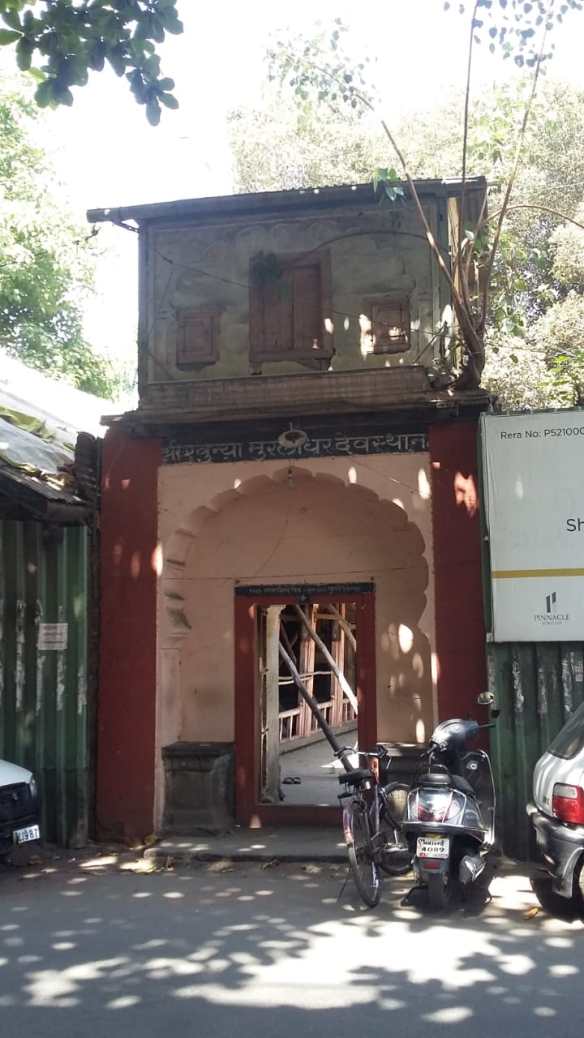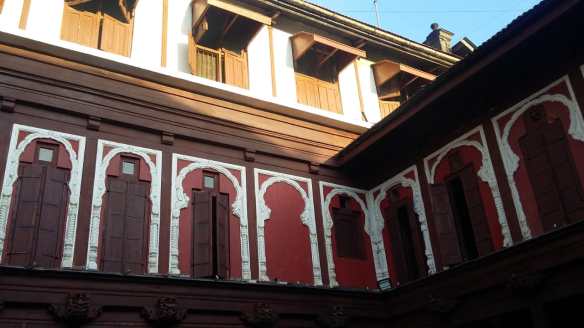Pune city is well known for its rich heritage and its strong connection with history. Every nook and corner of the city speaks volumes about golden past. Every road in the main city area has a story to tell.
Adding to the curiosity are the temples in Pune with its uncommon names like Upashi
Vitohbha, Dulya Maruti, Patrya Maruti, Jilbya Maruti Mandir etc.
(Do check the link given at the bottom of the blog for additional info on this)

The peak with its decorative
One of such strikingly different names to outsiders is Khunya Murlidhar temple. Murlidhar who with the soothing tones of his ‘Murli’ i.e. Flute has the power to calm the world, the Shrikrishna who played the important part of messenger of peace before the war of Mahabharat, the embodiment of ‘perfect man’, a political strategist who pledged not to use any weapon during the Mahabharat war, how his temple got such a name?
This name ‘Khunya Murlidhar’ is basically given based on the events which took place in the temple.

Temple Exterior View
History:
Sadashiv Gadre was one of the moneylenders in Second Bajirao Peshwa’s kingdom. Sadashiv Gadre built this temple in 1797 after he had a dream in which Murlidhar (Krishna) appeared in front of him and and instructed him to make the idols and build a temple in this place.
Gadre hired a sculptor named Bakhatram from Jaipur to make the beautiful idols. Peshwa Bajirao II happened to see these idols and liked them very much. He asked Dada Gadre to give him the idols, this demand was declined by Gadre and he asked the Khare family of Trimbakeshwar to worship the idols and install them in the temple overnight.
Accordingly, on 6 May 1797, Gadre shifted the idols from his home to this temple in the early morning and started the religious ceremony to install them here. Peshwa Bajirao came to know about this and sent a few British soldiers that were newly deployed in Pune to stop Gadre. But there was a defense in place as Gadre had deployed a few Arab soldiers that he had at his service to protect the temple.

Paintings and description on walls
While the religious ceremony was going on inside the temple, a battle raged outside between the British soldiers and the Arab defenders resulting in bloodshed and a number of deaths outside. As these murders (Khoon) happened outside, the temple got its name (Khunya) Murlidhar.

The main Hall of Khunya Murlidhar
Enraged by this, the Peshwa imprisoned Sadashiv Gadre in jail in Ahmednagar and confiscated all his properties. Gadre was in jail for 23 years and Khare family took care of the temple and the daily worshiping of the idols during this time. For his dedicated work, Gadre decided to handover the temple management and its surrounding area to the Khare family, which they are doing till date and the seventh generation of the Khare family currently manages the temple. Khare Vaidya, (expert of Ayurveda) is well known in #Pune to provide a traditional medicine for jaundice which has cured over thousands of people over the past many decades.

Other interesting facts:
Many other interesting stories are attached to this temple. Being a #Punekar by birth I have heard this story from many other natives. It is said that the Chaphekar brothers hatched the plan to assassinate Rand in this very temple. The brothers used to conduct secret meetings in the temple to plan the attack and assassination.
It is also said that a person staying close by, named Dravid, heard about this plan and tipped off the British about it which resulted in the capture and hanging of the Chaphekar brothers. It is also said that Dravid was also murdered later as revenge for passing on the information to Britishers.
The Temple architecture: The temple consists of courtyard, main Hall and sanctum sanctorum. The main hall is decorated with beautiful wooden pillars and decorative chandeliers. One can see some beautiful pictures, paintings on the wall. The main sanctum sanctorum of the temple is built in black basalt rock and the hall around it is built using a wooden frame structure. This hall has excellent carvings on the walls and columns that depict the typical artwork popular during those time.

The idol:
The idol of Shrikrishna is also unique and is seen standing on one leg and the support of the thumb of the other leg without any other support.The idol of Radha Krishna is carved out of white marble. In the temple do observe the Eagle which represents the vehicle of Lord Vishnu.
Every Janmashtami this temple is decorated with beautiful flowers, garlands, rangoli and diyas. This Janmashtami make sure to visit this temple and experience the eternal magic of Shrikrishna.

An interesting read:
One can read many interesting stories behind different names of temples in Pune on the following link.








